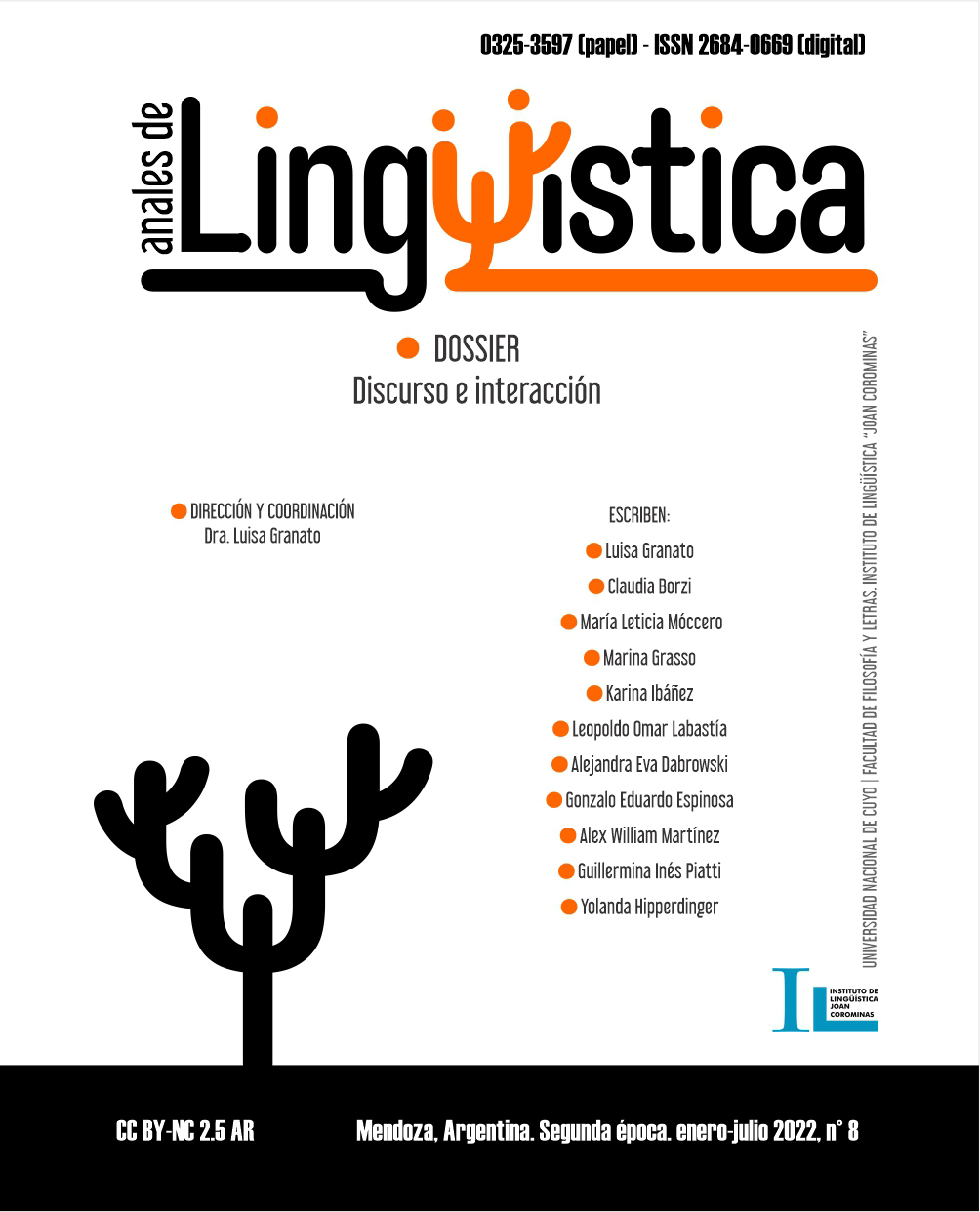Prosodic Characteristics of Two Political Discourse Practices
Keywords:
prosody, intonation, political discourse, phrase sequences, pragmaticsAbstract
The aim of this research is to investigate the prosodic realization of two political discourse practices, a speech and an interview, by the same speaker. The different nuclear tone configurations and the segmentation of speech in prosodic units are studied: intermediate phrases, intonational phrases and phrase sequences. In particular, the role of phrase sequences and their intonation in the organization of discourse is studied, together with their impact in the realm of politics. From the pragmatic point of view, this work is based on Relevance Theory (Sperber and Wilson1995; Wilson and Sperber 2004) to account for the procedural meaning of each nuclear tone configuration (Labastía 2011, 2016, 2018; Dabrowski and Labastía 2013). From the prosodic point of view, it is framed in the Autosegmental-Metrical model (Hualde, 2003) and the Sp_ToBI transcription system (Sosa 2003) applied to River Plate Spanish (Gabriel et al 2010). The different prosodic elements are identified and an auditory transcription is made of the initial fragments of both discourse practices, which is later corroborated by means of the PRAAT acoustic analysis software (Boersma and Weeninck 2019). The research reveals prosodic differences both in the segmentation of discourse and in the frequency of appearance of the different nuclear tone configurations. Besides, the distribution of the different configurations in the phrase sequences reveals different speaker stances in relation to his audience.
References
Bermúdez, M. y García Riverón, R. M. (2019). Demarcación prosódica de los paratonos en el discurso académico oral. Estudio experimental de una muestra de conferencias universitarias. Estudios de Fonética Experimental XXVIII, pp.185-227.
Blakemore, D. (1987). Semantic Constraints on Relevance. Oxford (UK): Blackwell.
Boersman, P. y Weeninck, D. (2019). PRAAT: Doing phonetics by computer. Recuperado de https://www.fon.hum.uva.nl/praat/
Brazil, D., Coulthard, M. y Johns C. (1980). Discourse Intonation and Language Teaching. London: Longman.
Brown, G., Currie, K. L., y Kenworthy, J. (1980). Questions of Intonation. Abingdon y New York: Routledge.
Canal Trece – Periodismo para Todos (17/06/2018). Jorge Lanata mano a mano con Mauricio Macri. Recuperado de https://www.youtube.com/watch?v=3HXXL0SXd84
Canellada, J. y Madsen-Kuhlman, J. K. (1987). Pronunciación del español: Lengua hablada y literaria. Madrid: Castalia.
Carston, R. (2016). The heterogeneity of procedural meaning. Lingua 175-176, pp. 154-166.
Casa Rosada – República Argentina (03/09/2018). Palabras del presidente Mauricio Macri. Recuperado de https://www.youtube.com/watch?v=sIoo6zKjX6A
Clark, B. (2007). ‘Brazing a trail’: moving from natural to linguistic meaning in accounting for the tones of English. En: R.A. Nielsen,N.A. Appiah Ampho y K. Borthen (Eds). Interpreting Utterances: Pragmatics and its Interfaces. Essays in honour of Thorstein Fretheim (pp. 69-81). Oslo: Novus.
Couper-Kuhlen, E. (1986). An Introduction to English Prosody. London: Edward Arnold. Tübingen: Niemeyer.
Dabrowski A. y Labastía, L. (2013). Prosodia y relevancia en el discurso. Selecciones tonales y altura tonal en el español rioplatense. En: L. Labastía (Ed.). Cuestiones de Fonética, Fonología y Oralidad. Volúmenes temáticos de la Sociedad Argentina de Lingüística (2012) (pp. 71-87). Mendoza: Editorial FFyL-UNCuyo y SAL.
Dabrowski, A., Guglielmone, M.A., Allende, M.P., Labastía, L. (2015). Estructuración del discurso: Declinación y selección tonal en español rioplatense. En: P.L. Luchini, M.A. García Jurado y U. Kickhöfel Alves (Eds.). Fonética y Fonología. Articulación entre enseñanza e investigación (pp. 244-255). Mar del Plata: Facultad de Humanidades, Universidad Nacional de Mar del Plata.
Escandell-Vidal, M. V. (1998). Intonation and procedural encoding: The case of Spanish interrogatives. En: V. Rouchota y A. Jucker (Eds.). Current Issues in Relevance Theory (pp.169-204). Amsterdam: John Benjamins.
Escandell-Vidal, M. V. (2002). Echo-syntax and metarepresentations. Lingua 112, pp. 871-900.
Escandell-Vidal, M. V. y Leonetti, M. (2000). Categorías funcionales y semántica procedimental. En: M. Martínez Hernández et al (Eds.). Cien años de investigación semántica: de Michel Bréal a la actualidad (vol. 1, pp. 363-378). Madrid: Ediciones Clásicas.
Escandell-Vidal, V., Leonetti, M. y Ahern, A. (2011). Procedural Meaning. Problems and Perspectives. Bingley (UK): Emerald.
Espinosa, G. y Dabrowski, A. (2019). Prosodia y prácticas discursivas en el español rioplatense. RASAL Lingüística Nº1 (2019), pp. 7-31.
Fretheim, T. (2002). Intonation as a constraint on inferential processing. En: B. Bel e I. Marlien (Eds.). Proceedings of the Speech Prosody 2002 International Conference (pp. 59-64). Aix-en-Provence: Laboratoire Parole et Langage, CRNS, y Université de Provence.
Gabriel, C., Feldhausen, I., Pešková, A., Colantoni, L., Lee, S.A., Arana, V. y Labastía, L. (2010) Argentinian Spanish Intonation. En: P. Prieto y P. Roseano (Eds.). Transcription of Intonation of the Spanish Language (pp. 285-317). München: Lincom.
Gabriel, C., Feldhausen, I. y Pešková, A. (2011). Prosodic phrasing in Porteño Spanish. En: C. Gabriel y C. Lleó (Eds.). Intonational Phrasing in Romance and Germanic. Cross-linguistic and bilingual studies (pp. 153-182). Amsterdam: John Benjamins.
Gutierrez, S. (2003). El discurso argumentativo. Una propuesta de análisis. Escritos, Revista del Centro de Ciencias del Lenguaje (27), pp. 45-66.
Gutierrez, S. (2005). Discurso político y argumentación: Ronald Reagan y la ayuda a los ‘contras’”. Cuadernos del TICOM Nº50, División de Ciencias Sociales y Humanidades. México: UAM-Xochimilco. Recuperado de https://www.researchgate.net/publication/ 251886295_DISCURSO_POLITICO_Y_ARGUMENTACION
Hidalgo Navarro, A. (1996). La entonación coloquial. Función demarcativa y unidades de habla. Valencia: Cuadernos de Filología. Anejo XXI, Facultat de Filologia Universitat de València.
House, J. (1990). Intonation structures and pragmatic interpretation. En Ransaram, S. (Ed.). Studies in the Pronunciation of English (pp. 38-57). London: Routledge.
House, J. (2006). Constructing a context with intonation. Journal of Pragmatics 38 (10), pp. 1542-1558.
Hualde, J. I. (2003). El modelo métrico y autosegmental. En: P. Prieto (Ed.). Teorías de la Entonación (pp. 155-184). Barcelona: Ariel Lingüística.
Labastía, L.O. (2011). Procedural encoding and tone choice in Buenos Aires Spanish. En: V. Escandell-Vidal, M. Leonetti y A, Ahern (Eds.). Procedural Meaning. Problems and Perspectives (pp. 383-413). Bingley (UK): Emerald.
Labastía, L. O. (2016). Declarative utterances in Buenos Aires Spanish. En: M. Armstrong, N. Henriksen y M.M. Vanrell (Eds.). Intonational Grammar in Ibero Romance: Approaches across linguistic subfields (pp. 297-226). Amsterdam: John Benjamins.
Labastía, L.O. (2018). Entonación y estructura informativa en el español rioplatense. Tesis doctoral. Madrid: Universidad Nacional de Educación a Distancia. Recuperado de: http://espacio.uned.es/fez/eserv/tesisuned:ED-Pg-Filologia Lolabastia/LABASTIA_URGUELLES_ LeopoldoOmar_Tesis.pdf
Labastía, L., Dabrowski, A. y Guglielmone, M.A. (2013). Prosody and discourse structure in Buenos Aires Spanish. Leitura 52, pp. 228-246.
Ladd, D. R. (2008). Intonational Phonology. Cambridge (UK): Cambridge University Press.
Navarro Tomás, T. (1971). Manual de Pronunciación Española. Madrid: Guadarrama.
Nespor, M. y Vogel I. (2007). Prosodic Phonology. Berlin, New York: Mouton de Gruyter.
Pierrehumbert, J. (1980). The phonology and phonetics of English Intonation. PhD Thesis. Cambridge (MA): MIT.
Sosa, J.M. (2003). La notación tonal del español en el modelo SP_ToBI. En Prieto, P. (Ed.). Teorías de la Entonación (pp. 185-208). Barcelona: Ariel Lingüística.
Sperber D. y Wilson, D. (1994). Relevancia. Comunicación y Procesos Cognitivos. Madrid: Visor.
Sperber D. y Wilson, D. (1995). Relevance. Communication and Cognition (2da ed.). Oxford (UK): Blackwell.
Van Dijk, T. (1995). What is political discourse analysis? En: J. Blommaert y C. Bulcaen (Eds.). Political Linguistics (pp. 11-52). Amsterdam: John Benjamins.
Verón, E. (1987). La palabra adversativa. Observaciones sobre la enunciación política. En: E. Verón (Ed.). El Discurso Político (pp. 13-26). Buenos Aires: Hachette.
Wichmann, A. (2000). Intonation in Text and Discourse. Harlow: Longman.
Wilson, D. and Sperber D. (2004). Relevance Theory. En: L.R. Horn y G. Ward (Eds.). The Handbook of Pragmatics (pp. 607-632). Oxford (UK): Blackwell.
Wilson, D. y Sperber, D. (2012). Linguistic Form and Relevance. En: D. Wilson y D. Sperber (Eds.). Meaning and Relevance (pp. 149-168). Cambridge (UK): Cambridge University Press.
Downloads
Published
How to Cite
Issue
Section
License
Copyright (c) 2022 Leopoldo Omar Labastía, Alejandra Eva Dabrowski, Gonzalo Eduardo Espinosa, Alex William Martínez
Esta obra está bajo una Licencia Creative Commons Atribución 2.5 Argentina.
Los/as autores/as que publican en esta revista están de acuerdo con los siguientes términos:
1. Los/as autores conservan los derechos de autor y garantizan a la revista el derecho de ser la primera publicación del trabajo bajo una licecncia Creative Commons Atribución 2.5 Argentina (CC BY 2.5 AR) . Por esto pueden compartir el trabajo con la referencia explícita de la publicación original en esta revista.
2. Anales de lingüística permite y anima a los autores a difundir la publicación realizada electrónicamente, a través de su enlace y/o de la versión postprint del archivo descargado de forma independiente.
3. Usted es libre de:
Compartir — copiar y redistribuir el material en cualquier medio o formato
Adaptar — remezclar, transformar y construir a partir del material para cualquier propósito, incluso comercialmente.












